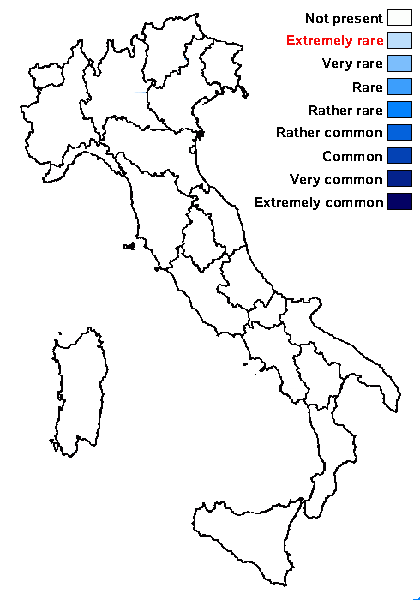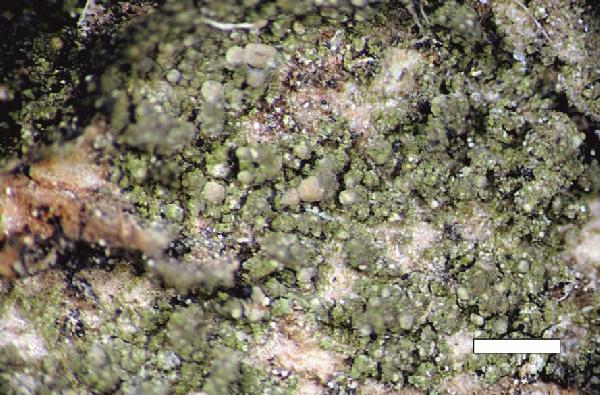Micarea czarnotae Launis, van den Boom, Sérus. & Myllys
in Launis & al., Lichenologist, 51: 18, 2019.
Synonyms:
Distribution:
Description: Thallus crustose, episubstratic, pale to dark olive green, granular, composed of 20-35(-40) µm wide goniocysts which usually coalesce into an almost continuous, sometimes cracked crust, without internal crystalline granules visible under polarized light. Apothecia often crowded, 0.1-0.3 mm across, flat to hemispherical, sometimes tuberculate and then up to 0.4 mm across, cream-white to pale brown, often with a greyish tinge, emarginate. Proper exciple poorly developed, usually indistinct; epithecium colourless or pale grey, K± and C± violet; hymenium colourless, 30-45 µm high, inspersed with crystals visible under polarized light; paraphyses numerous, branched, 1-1.5 µm thick, the apical cells not swollen; hypothecium colourless. Asci 8-spored, clavate, in K/I with a blue outer layer and apical dome and unstained wall, the dome with an apical cushion, 35-40 x 8-10 µm. Ascospores simple or 1-septate, hyaline, oblong-ellipsoid or obovoid, 7-10 x 2.25-3.5 µm. Pycnidia whitish, of 2 types: a) mesopycnidia often numerous and sessile, sometimes immersed in surrounding goniocysts, c. 70-100 µm wide, globose or doliiform, sometimes with a gaping ostiole extruding white conidial mass, producing cylindrical or cylindrical-fusiform mesoconidia measuring 4-5(-5.5) x 1.1.5 µm, b) micropycnidia immersed in surrounding goniocysts or sessile, 80-130 µm wide, globose, if sessile often with a gaping ostiole, producing filiform to narrowly fusiform microconidia measuring 5.5-7 x 0.8-1(-1.2) µm. Photobiont micareoid, the cells 4.5-7.5 µm wide. Spot tests: thallus K-, C-, KC-, P-, UV-. Chemistry: thallus and apothecia with methoxymicareic acid; pigmented parts of apothecia with the Sedifolia-grey pigment.Note: a recently-described species growing on the acid bark of coniferous and deciduous trees, known from Northern and Central Europe, but perhaps more widespread. To be looked for in the Italian Alps.
Growth form: Crustose
Substrata: bark
Photobiont: green algae other than Trentepohlia
Reproductive strategy: mainly sexual

Predictive model

Source: Kantelinen, A., Westberg, M., Owe-Larsson, B. & Svensson, M. 2021. New Micarea records from Norway and Sweden and an identification key to the M. prasina group in Europe. Graphis Scripta 33 (2): 17–28. Oslo. ISSN 2002-4495. - CC BY-4.0
Micarea czarnotae (L-985764). Scale bar 1 mm. Photo originally published by Launis et al. 2019a, reprinted with permission of the British Lichen Society and Cambridge University Press.
Growth form: Crustose
Substrata: bark
Photobiont: green algae other than Trentepohlia
Reproductive strategy: mainly sexual

Predictive model


